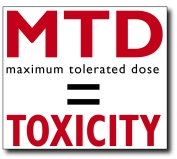Practicing Clinical Oncologists to the Rescue
May 20, 2015 Leave a comment
Cancer patients and their physicians can find themselves at the wrong end of many scientific discoveries. For example, the drug capecitabine, sold commercially as Xeloda, was originally marketed at a daily dose of 2500 mg/m2 given for two weeks.
This schedule developed by the pharmaceutical investigators, is known as the maximum tolerated dose (MTD) and it performed well against other regimens for breast and colon cancer. With an FDA approval in hand, oncologists began administering the drug on the recommended schedule.
 It did not take long before physicians and their patients realized that 2500 mg/m2/day was more than many patients could tolerate. Hand-foot Syndrome (an inflammation of the skin of palms and soles), mucositis (oral ulcers) myelosuppression (lowered blood counts) and diarrhea were all observed. Immediately clinical physicians began to dose de-escalate. Soon these astute practitioners established more appropriate dose schedules and the drug found its rightful place as a useful therapeutic in many diseases.
It did not take long before physicians and their patients realized that 2500 mg/m2/day was more than many patients could tolerate. Hand-foot Syndrome (an inflammation of the skin of palms and soles), mucositis (oral ulcers) myelosuppression (lowered blood counts) and diarrhea were all observed. Immediately clinical physicians began to dose de-escalate. Soon these astute practitioners established more appropriate dose schedules and the drug found its rightful place as a useful therapeutic in many diseases.
What was interesting was that activity continued to be observed. It appeared that the high dose schedule was simply toxic and that lower doses worked fine, with fewer side effects.
Modern targeted agents have been introduced over recent years with dose schedules reminiscent of capecitabine. The drug sunitinib, approved for the treatment of renal cell carcinoma, is given at 50 mg daily for four weeks in a row, followed by a two week rest. Despite good activity, toxicities like mucositis and skin rash often set in by the third week. What remained unclear was whether these schedules were warranted. A recent report in the Annals of Oncology examined this very question. In a retrospective analysis of patients with kidney cancer the physicians found that lowering the dose of sunitinib preserved activity but reduced toxicity.
As a practitioner, I have long reduced my patient’s schedule of sunitinib to two weeks on, one week off or even 11 days on, 10 days off. In one patient that I treated for a gastrointestinal stromal tumor (GIST), I achieved a durable complete remission with just 25 mg/day, given seven days each month, a remission that persists to this day, seven years on.
We are in a new world of targeted therapy, one in which very few people understand the kinetics, pharmacodynamics and response profiles of patients for novel drugs. In our laboratory, favorable dose response curves often suggest that many agents could be administered at lower doses. More interestingly, some patients who do not carry the “targets” for these drugs nonetheless respond. This has broad implications for multi-targeted inhibitors like sunitinib that can influence multiple targets simultaneously.
As so often happens, it is the nimble clinical physicians with their feet on the ground, confronting the very real needs of their patients who can outmaneuver and outthink their academic colleagues. The trend toward consolidation in medicine and the absorption of clinical practices into hospital groups all using standardized algorithms has the risk of stifling the very independence and creativity of practicing oncologists that has proven both effective and cost-effective for our patients and our medical system at large.


